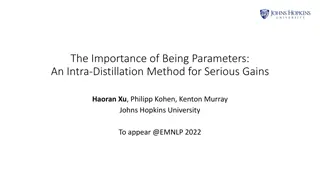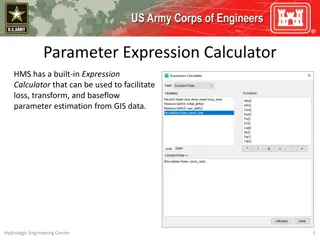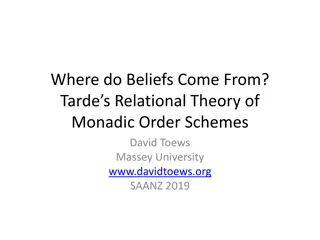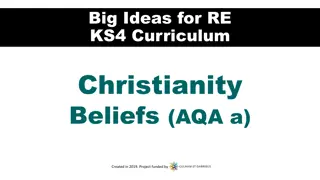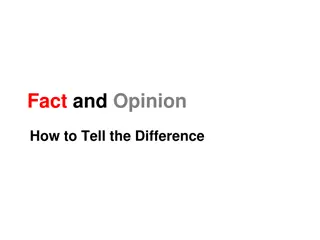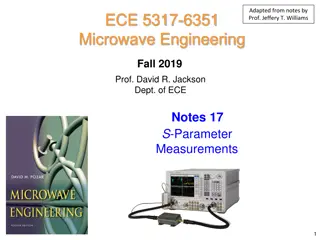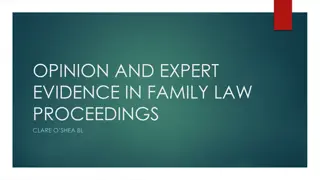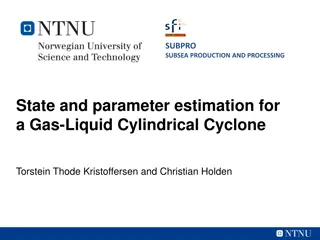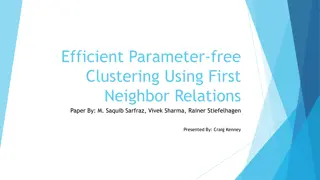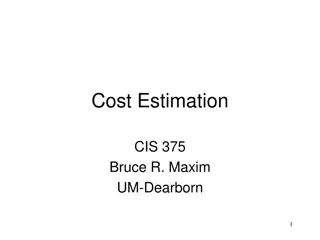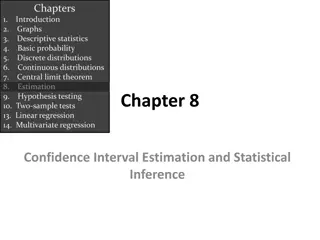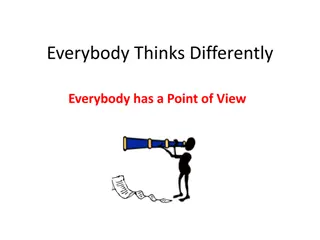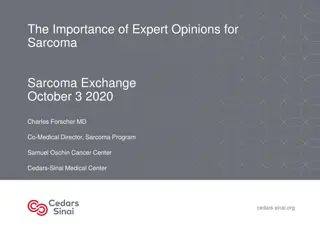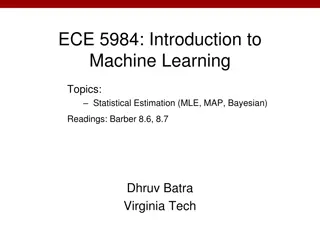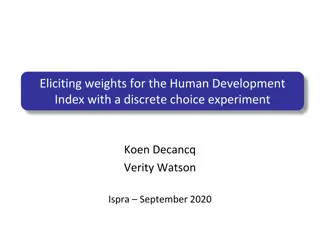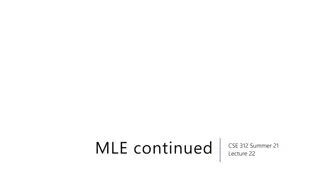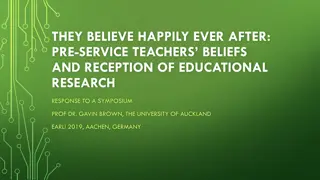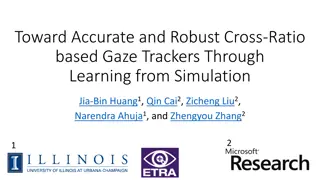Understanding Prior Beliefs and Eliciting Expert Opinions in Parameter Estimation
Prior beliefs play a crucial role in estimating parameters of interest before observing events. They can be elicited from sources like meta-analyses, literature, and expert opinions. Experts' beliefs are often measured using Beta or Normal distributions for different outcomes. Eliciting prior beliefs on proportions involves tasks like uncertainty representation and point estimation. The way questions are framed can influence answers, and elicitation techniques are used to capture experts' qualitative knowledge.
Download Presentation

Please find below an Image/Link to download the presentation.
The content on the website is provided AS IS for your information and personal use only. It may not be sold, licensed, or shared on other websites without obtaining consent from the author. Download presentation by click this link. If you encounter any issues during the download, it is possible that the publisher has removed the file from their server.
E N D
Presentation Transcript
Prior beliefs Prior belief is knowledge that one has about a parameter of interest before any events have been observed For example, you may have an idea of what the prevalence of flu was last week. Not all events can be observed without any bias Prior belief comes into play to know what the biases may be and how to adjust them. They are crucial to the estimation of sample sizes
Prior beliefs The probability distribution functions learnt previously can be used to represent prior belief. Prior beliefs can be elicited from 3 majors sources Previous meta analyses which results can be directly transformed into pdf to represent belief Previous literature but without meta analysis, which would require more work to put into pdf Experts opinion, which can be challenging to assess and to put into a pdf.
Eliciting prior beliefs from experts Experts belief are most often measured as Beta( , ) for binomial outcomes Normal( , ) for continuous outcomes The elements of the belief to be measured are Point estimates: means, medians and/or modes. Quantiles or variances that give the expert s confidence in their point estimates. Co-variances that quantify relationships between the point estimates. (Others. e.g. point estimates of correlations)
Eliciting prior beliefs on proportions Includes 2 tasks Eliciting the pdf (uncertainty, variance) Let be the date in which the first human settlers arrived in Europe. What probability distribution represents your uncertainty about ? Let be the proportion of adult males in the population who are involved in road accidents in the given year. What probability distribution represents your uncertainty about ? Eliciting the actual proportion (point estimate) Estimate the probability of an adult male being involved in a road accident this year. Taken from Oakley et al. 2010
Eliciting prior beliefs on proportions The way the questions are asked can influence the answer Recent experience with what is being measured Presenting the problem using percentages vs asking about X out of 100 or X out of 1000 Anchoring (see later) Listing of options Taken from J. Oakley (Ed.), Eliciting Univariate Probability Distributions, Risk Books, London (2010)
The psychology of eliciting beliefs From Winkler, 1967: The [expert] has no built-in prior distribution that is there for the taking. That is, there is no `true' prior distribution. Rather, the [expert] has certain prior knowledge which is not easy to express quantitatively without careful thought. An elicitation technique used by the [facilitator] does not elicit a `true' prior distribution, but in a sense helps to draw out an assessment of a prior distribution from the prior knowledge. Different techniques may produce different distributions because the method of questioning may have some effect on the way the problem is viewed."
Preparing the elicitation exercise Make sure the expert understands the difference between eliciting a pdf vs a probability per se (ie a prevalence) Clearly explain that precision is not the goal, uncertainty is Give an example of the difference between randomness and uncertainty Taken from J. Oakley (Ed.), Eliciting Univariate Probability Distributions, Risk Books, London (2010)
Preparing the elicitation exercise Make sure the expert reflects his/her own uncertainty, not that of others Explain why experts belief is important in contrast to collecting data. In practice examples, get the expert to react to possible parameter values (should not be done in the actual elicitation) Taken from J. Oakley (Ed.), Eliciting Univariate Probability Distributions, Risk Books, London (2010)
Identifying the role of the elicitation Strong, directly relevant evidence Experts may not be needed in such a situation Indirectly relevant evidence For ex, data with misclassification error Could ask about Se/Sp of the measurement tool Could ask about another population Expert opinion only Taken from J. Oakley (Ed.), Eliciting Univariate Probability Distributions, Risk Books, London (2010)
Structuring the elicitation problem From Smith (1998) it is paramount to spend a significant proportion of my time eliciting structure: dependencies, functional relationships and the like. For ex, ask to list categories of a categorical variable before asking for uncertainty about their frequency Ask to estimate a parameter and the ratio of one parameter to the other (instead of 2 dependent parameters) Taken from J. Oakley (Ed.), Eliciting Univariate Probability Distributions, Risk Books, London (2010)
Steps in eliciting a distribution 1. The expert makes a small number of probabilistic judgments about . 2. The facilitator fits a suitable parametric probability distribution to the expert's judgments. 3. The facilitator reports features of the distribution back to the expert, and asks the expert whether the fitted distribution is an acceptable representation of her beliefs. 4. If the distribution is acceptable to the expert then the elicitation is concluded. Otherwise, the facilitator fits an alternative distribution, usually based on modified or additional probabilistic judgments from the expert. Taken from J. Oakley (Ed.), Eliciting Univariate Probability Distributions, Risk Books, London (2010)
Methods to elicit knowledge Fixed interval Expert is asked for probabilities of the form P(a < < b). Variable interval Expert is asked for quantiles; for example, the expert is asked for the value a such that P(a < ) = 0.25. Software / R codes SHELF, MATCH Taken from J. Oakley (Ed.), Eliciting Univariate Probability Distributions, Risk Books, London (2010)
Fixed interval Probability method The expert is asked to specify several probabilities of the form P(a < < b). In MATCH, if the range of X is [0,1], then the default probabilities asked for are P(0 < X < 0.25), P(0.75 < X < 1) and P(0 < X < 0.5) In the original method, the expert is asked for 5 probabilities (r is the mode here): p1 =P { Xmin < < r } p2 = P { Xmin < X < (Xmin + r)/2) } p3 = P { (r + max)=2 < < max} p4 = P {Xmin < < (Xmin + 3r)/4 } p5 = P { (3r + Xmax)/4 < < Xmax } Very hard to achieve
Fixed interval - Roulette method The expert is ask to first determine the interval of possible values A graph with a fixed number of bins is generated The expert is asked to place a pre-determined number of chips in the bins See ex. in MATCH Taken from: Morris et al. A web-based tool for eliciting probability distributions from experts. Environmental Modelling & Software 52 (2014) 1-4
Variable interval bisection or quartile method The expert specifies the median, lower quartile and upper quartile of X. To assess median, the facilitator asks Choose a value m, such that you judge the two intervals [0;m] and [m; 1] to have the same probability of containing . To ascertain quartiles, the facilitator asks Divide the interval [0;m] into two equally probable intervals [0; l] and [l;m]. The facilitator would then ask if the expert thinks that the intervals [0;l], [l;m], [m,u] and [u,1] all seem as probable as one another. Then the pdf and the expert is asked if it reflects their belief.
Variable interval tertile method The expert specifies the median, the 33rd percentile and the 66th percentile. The method is very similar to that of the quartile. Experts may find it easier to divide their beliefs in thirds instead of quarters
Feedback After the pdf have been generated, then the facilitator will ask the expert questions about some values on the distribution. For example, how likely would a value corresponding to the 99th percentile be? Does it represent their beliefs etc. Values can be modified to best fit the belief of the expert.
4 principles of eliciting prior knowledge Principle 1: It is desirable for elicitation methodologies to produce distributions which are flexible in form. Principle 2: It is desirable to minimize the cognitive demands that an elicitation methodology places on the expert. Principle 3: It is desirable to minimize the demands that an elicitation methodology places on the statistician. Principle 4: All other things being equal, methodologies for prior elicitation which can be easily applied to a wide range of models or scenarios may have some added desirability. Taken from Hahn., Re-examining informative prior elicitation through the lens of MCMC. Journal of the Royal Statistical Society: Series A 2006; 169, 37 48.


